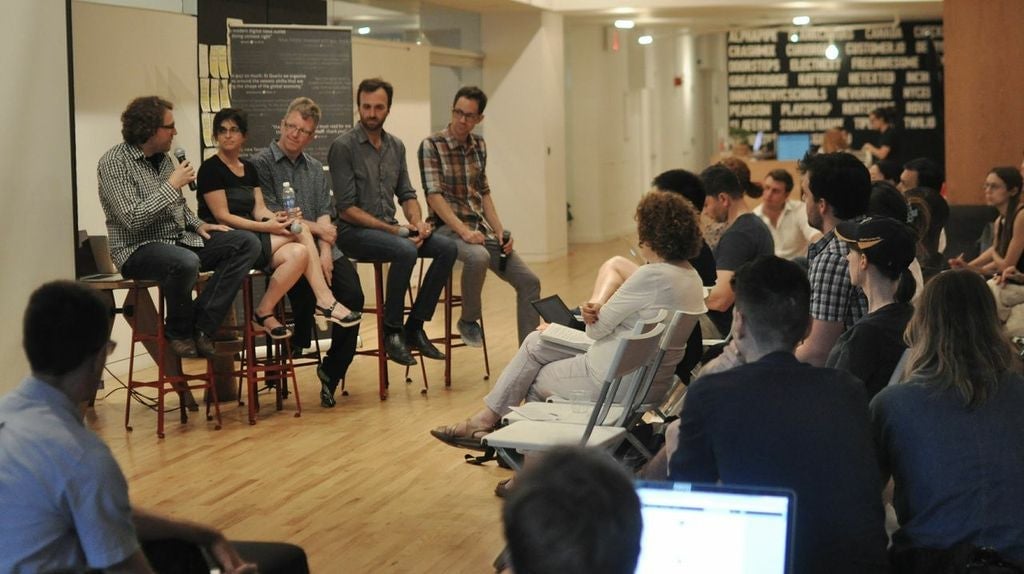Three things you need to understand about 3D printing to talk about it intelligently
Several of the biggest brains in 3D printing joined Quartz for a discussion about the future of the technology at General Assembly in New York City on July 16. Here are the three most interesting things we learned.


Several of the biggest brains in 3D printing joined Quartz for a discussion about the future of the technology at General Assembly in New York City on July 16. Here are the three most interesting things we learned.
1. Customization is effectively free with 3D printing
The upsides of 3D printing are all about total customization. Joergen Geerds, an artist and entrepreneur known for his use of 3D printers to make panoramic photography, pointed out that the NASA US space agency is now using 3D printers to make otherwise expensive rocket components. And doctors are using 3D printers to produce custom hip replacements that fit patients perfectly.
“Complexity is free,” said Duann Scott of 3D printing market Shapeways. ”So customization is free.” A room full of identical chairs costs much less than a room full of custom-fit seats when you use traditional manufacturing methods—but with 3D printing they cost exactly the same as their bespoke counterparts, as long as the materials are the same. That’s because you can use a different design for each individual item without resetting machinery or making new molds.
2. Software needed for 3D printing will get easier by necessity
Standard CAD product engineering software takes hundreds of hours to learn, mostly because it’s not about creating a literal model of what you want to print.
“You’re planning for the things enacted in the manufacturing process that will make the shape you want,” said Matthew Griffin of Adafruit, a site for buying electronics parts and learning how to tinker with them. “It’s kind of a proxy. You have to learn the metaphors and just go native, but before that point it can be frustrating to even navigate the design space.”
But there is already a range of options for 3D printing software, said Lizabeth Arum of 3D printer maker Makerbot’s nonprofit educational initiative makerbot.org. She’s seen middle school students take to some, like Tinkercad, incredibly quickly. “As years go on, it’s going to get easier and easier.”
Soon, it may even be as simple as playing a game. Scott recounted the story of a university student who’d created a model of his campus on the boxel-based building game Minecraft. It took 600 hours, but he told reporters that it hadn’t been a laborious process. He’d just been playing.
“When I started using 3D printing, I had a paradigm shift from pixel based worlds into an engineering based world, which was difficult,” Geerds said, “So I’m hoping that we see a model like Minecraft soon.”
3. 3D printing isn’t good for a lot of things
Easier interfaces are key to making 3D printing mainstream, the panel agreed, but material limitations are also a concern. “Right now,” Scott said, “You can only use one material at a time. Most things around you are made from multiple materials. This microphone has a shit ton of stuff inside of it.” Not being able to print electronics and their casings in one go, the panelists said, was a major drawback.
There are plenty of things (like firearms) that you could probably make with a 3D printer, but shouldn’t—and not just because of possible legal issues. The mechanisms of a gun aren’t easily produced by a 3D printer, and will perform sub-optimally. This concept, Scott said, extends to other products as well: Just because we can print it doesn’t mean we ever will.
And 3D printing won’t be changing the way all manufacturing works, the panelists agreed. “It’s not a place for manufacturing, it’s a place for prototyping,” Arum said, “And it has certain uses, but it won’t transform everything.”
Griffin concluded that most of the overhype of 3D printing comes from a misunderstanding of what exactly a 3D printer is. “There’s a lot of conflation, with people saying we’re 3D printing organs and key fobs,” Griffin said. “But they’re talking about different machines and different goals. The machines are evolving so separately.” The fact that one expensive, highly specialized machine can print cars from carbon fiber filament, he said, doesn’t mean that this is something all 3D printers will be enlisted to do.